AUTHORS
CATEGORIES
- Airsoft (2)
- Austin (8)
- Books (9)
- Cooking For Engineers (20)
- Credit Cards (2)
- Current Events (9)
- Deals (4)
- Dining (37)
- Fanpop (4)
- Food (808)
- Games (5)
- Hairy (6)
- Kitchen Gear (7)
- Life (24)
- Miscellaneous (6)
- Movies (15)
- Orthogonal Thought (6)
- Personal Computers (10)
- Photography (158)
- Rant (9)
- Ruby on Rails (2)
- San Francisco (5)
- Soap Making (5)
- Television (11)
- Texas (1)
- Things We Like (11)
- Travel (11)
- Wear or Not (1)
- Web 2.0 (9)
- What I Ate (861)
- Wikipedia (5)
- Windows 10 (3)
- Windows Mobile (1)
- WordPress (1)
ARCHIVE
- September 2018 (1)
- September 2017 (1)
- March 2017 (1)
- September 2016 (2)
- August 2016 (2)
- September 2015 (1)
- November 2014 (1)
- August 2014 (1)
- January 2014 (1)
- September 2013 (1)
- December 2012 (1)
- November 2012 (3)
- September 2012 (1)
- August 2012 (2)
- June 2012 (2)
- February 2012 (1)
- January 2012 (4)
- December 2011 (4)
- October 2011 (2)
- September 2011 (5)
- August 2011 (1)
- July 2011 (2)
- April 2011 (2)
- February 2011 (5)
- January 2011 (12)
- December 2010 (37)
- November 2010 (30)
- October 2010 (25)
- September 2010 (30)
- August 2010 (32)
- July 2010 (34)
- June 2010 (31)
- May 2010 (35)
- April 2010 (35)
- March 2010 (33)
- February 2010 (34)
- January 2010 (33)
- December 2009 (30)
- November 2009 (31)
- October 2009 (30)
- September 2009 (31)
- August 2009 (34)
- July 2009 (34)
- June 2009 (34)
- May 2009 (33)
- April 2009 (32)
- March 2009 (42)
- February 2009 (38)
- January 2009 (57)
- December 2008 (40)
- November 2008 (30)
- October 2008 (33)
- September 2008 (22)
- August 2008 (5)
- July 2008 (5)
- June 2008 (11)
- May 2008 (13)
- April 2008 (10)
- March 2008 (29)
- February 2008 (18)
- January 2008 (28)
- December 2007 (1)
- November 2007 (4)
- October 2007 (5)
- September 2007 (10)
- August 2007 (14)
- July 2007 (10)
- June 2007 (9)
- May 2007 (21)
- April 2007 (21)
ACTIONS
What I Ate: September 11, 2010 (Ruth's Chris Steak House)
Posted 12 September, 2010 at 11:16pm by Michael Chu(Filed under: Food, What I Ate)
Dinner: We decided to go to Ruth's Chris Steak House (107 West 6th Street, Austin, TX - (512) 477-7884) because it keeps coming up in conversations about steak and steak houses (as in: "So they make a good steak? How does it compare to Ruth's Chris?"). We've eaten at quite a few steak houses (Peter Luger in Brooklyn really is the best so far) but never a Ruth's Chris, so we decided it was time.
They have a special oven at Ruth's Chris which supposedly runs at 1800°F (980°C). They took me back through the kitchen to see the ovens which are pretty much just triple wide and extra deep salamanders with roll out grills that come all the way out to access steaks placed in the back. I was unable to verify the temperature because my IR thermometer maxes out at 900°F. I was also not allowed to take pictures of the oven.
Cooking a steak at such a high temperature is an interesting technique, but not really necessary. It allows them to get a good sear in a short period of time. This lets the steaks cook quickly (not much waiting time so the food can go out the to customer quickly) and a large temperature gradient within the steak (well browned outside while still having a rare or medium-rare interior). Unfortunately, cooking at these high temperatures means you won't be getting a thick cut large steak because in a 2-in ribeye, the exterior would have charred by the time the interior has warmed up. It's difficult to compare Ruth's Chris's oven temperatures to other steak houses because most other steak houses do not use an oven to cook a steak. When an oven is involved at most other steak houses, it's to bring the steak up to temperature after a sear (on a grill or pan) is first applied (although the temperature is lower, heat conductivity of a pan is much higher than that of air, so the steak actually browns faster without heating the interior on a pan than in an 1800°F oven). So, when they tell you that their oven runs at 1800°F its an interesting fact, but not something useful when comparing to other cooking techniques - it's just different. I prefer thicker steaks, so I probably won't even build myself an 1800°F oven to replicate this technique (especially since I think the sous vide technique is perfect for cooking the ultimate steak at home).
We ordered a couple appetizers to begin and I was pleased with both.
Louisiana Seafood Gumbo ($8.50). Their gumbo leans towards the soupy (vs thick and heavy) side and although it did not contain any okra but had excellent flavor.
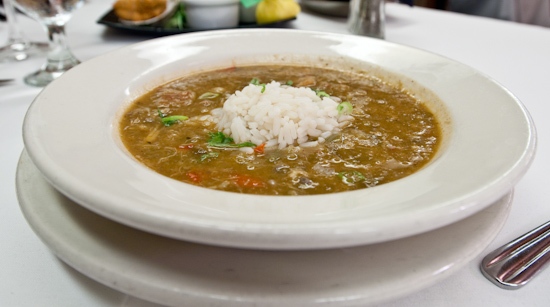
Fried Oysters ($14 for a full order). I managed to convince them to serve me a half order - normally these come six in a full order. The oysters were great - crunchy and tasty (seasoned but not heavily) breading and silky oysters with just a hint of the sea.
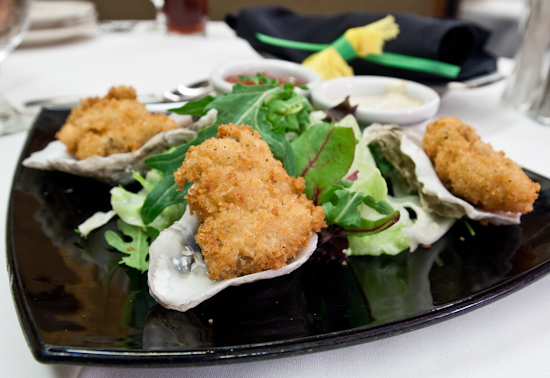
Cowboy Ribeye A huge bone-in version of this USDA Prime cut. ($43.95). Ruth's Chris serves their "huge" (although I found it smaller than the steaks I'm used to cooking) steaks drenched in butter on plates that come out of a 500°F (260°C) oven. The plates themselves aren't 500#176;F when they arrive at the table (ours was 300°F) but they are hot enough to serve their purpose (keep the steak hot through the entire meal) and cause a problem (continues to cook one side of the steak while you eat). The steak arrived with an internal temperature of 122°F and from the look and texture, the least done portions were at just under 130°F when it was pulled from the oven. Since I ordered it medium-rare, I was happy that that was what we received. Until two minutes later.
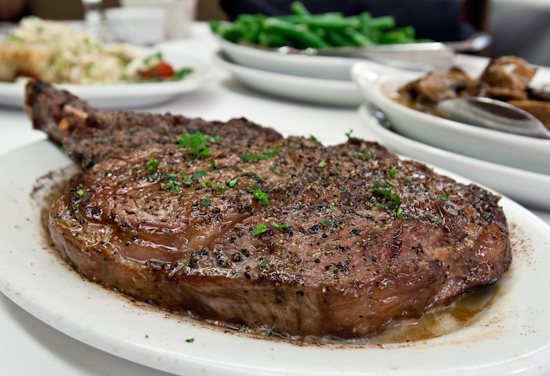
After a couple minutes, the steak was a little chewy in parts. This surprised both me and Tina until we realized what was happening. In this photo you can see that the super hot plate that the steak was served on has cooked it such that 50% of it is well-done. What a way to ruin a good steak. (The plates at Peter Luger were also heated and the steaks served on sizzling fat, but not to the temperatures that these plates were - so no overcooking problems.)
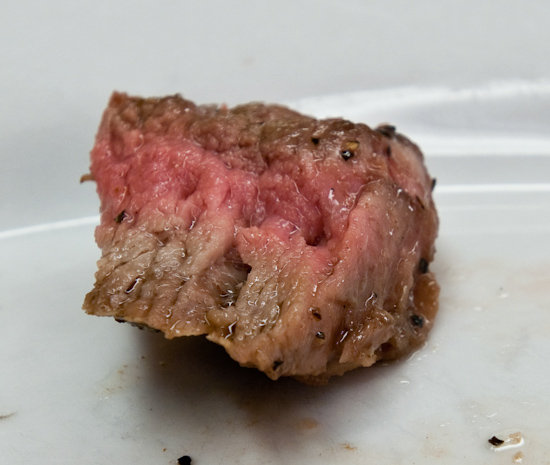
Alaskan Halibut Pan-seared over a bed of sauteed spinach and topped with crabmeat and parsley pesto ($35.95). This dish actually came with more crab sprinkled on top, but Tina didn't realize I hadn't photographed it yet and started eating. In the dim restaurant lighting, she didn't realize the sprinkles of crabmeat weren't flakes of fish that had broken off the halibut… so there should have been more crab meat in the photo. The fish was 155°F when it arrived at our table on a 250°F plate. The fish was protected by a bed of greens (spinach?) on a pool of butter, so it didn't overcook while on the plate. The halibut was perfectly pan-seared and quite flavorful, but switching between the intense flavor of the steak and the lighter (and yet still heavy in butter) flavor of the halibut, it was hard to want to keep eating the halibut over the steak.
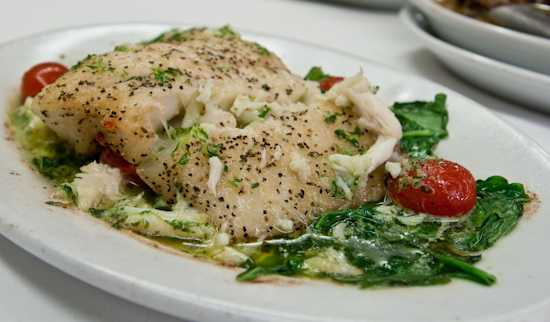
Wild Mushrooms Roasted with garlic and fresh herbs then sauteed in veal demi-butter ($11). This would have been a great pairing with the steak… if the steak wasn't USDA Prime and drenched in clarified butter. As it was, I felt the steak was too rich to eat with the mushrooms (even though this was an excellent mushroom preparation).
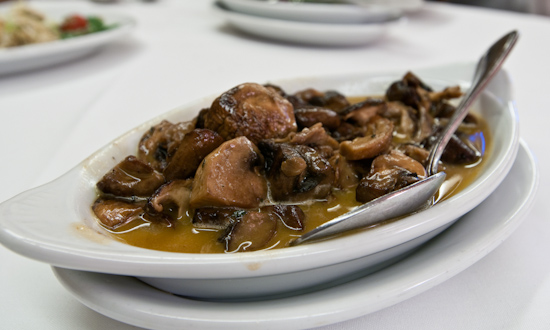
Green Beans Fresh green beans sauteed with roasted garlic, butter and seasonings ($8.85). Despite the heavy use of butter, the green beans were quite bland. The roasted garlic cloves scattered within the green beans were excellent though.
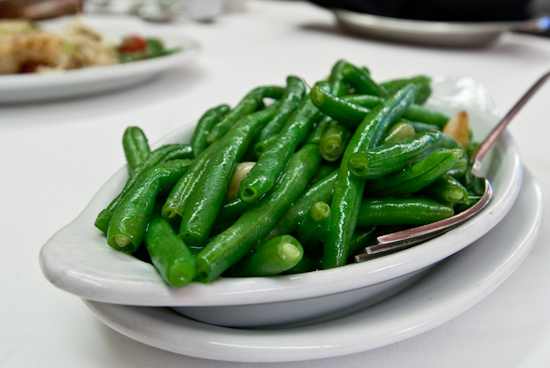
In the end, I have to say that Ruth's Chris makes a pretty good steak, but there are plenty of places that do steak just as well or better with just as good of a sear / crust and perfectly cooked interior. The 1800°F oven is more gimmick than necessity (or simply a way for the restaurant to cook their food faster to bring it to the table faster than other steak houses) and the 500°F plates actually ruin the steak. If you find yourself here, order the steak rarer than you like it so the plate has some leeway as it cooks on your table. Otherwise, expect it to arrive perfectly cooked but become overcooked within minutes. Also, we found ourselves eating less than we normally would simply due to the heavy, heavy usage of clarified butter everywhere.
I had a glass of Rodney Strong Cabernet Sauvignon (Alexander Valley) with my meal and though it was an excellent red wine to drink with the meal.